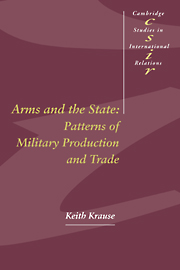Book contents
- Frontmatter
- Contents
- List of figures
- List of tables
- Acknowledgements
- Introduction
- 1 Motive forces in the evolution of the arms transfer and production system
- 2 The emergence of a global arms transfer and production system
- 3 From the Military Revolution to the Industrial Revolution
- 4 An overview of the post-1945 global arms transfer system
- 5 The dominance of first-tier producers and suppliers
- 6 Second-tier producers and suppliers: the struggle to keep pace
- 7 Dependent production and exports in the third tier
- 8 The subordinate role of arms recipients
- Conclusion
- Appendix: Arms transfer data sources and problems
- Notes
- Bibliography
- Index
6 - Second-tier producers and suppliers: the struggle to keep pace
Published online by Cambridge University Press: 22 September 2009
- Frontmatter
- Contents
- List of figures
- List of tables
- Acknowledgements
- Introduction
- 1 Motive forces in the evolution of the arms transfer and production system
- 2 The emergence of a global arms transfer and production system
- 3 From the Military Revolution to the Industrial Revolution
- 4 An overview of the post-1945 global arms transfer system
- 5 The dominance of first-tier producers and suppliers
- 6 Second-tier producers and suppliers: the struggle to keep pace
- 7 Dependent production and exports in the third tier
- 8 The subordinate role of arms recipients
- Conclusion
- Appendix: Arms transfer data sources and problems
- Notes
- Bibliography
- Index
Summary
The evolution of second-tier arms production and transfers
Matters become more complex as one surveys the policy and practice of second-tier arms producers and suppliers. The first difficulty is specifying which states are in the second tier. If membership is determined by production endowments and technological capabilities, tables 9 and 10 confirm that there is a qualitative gap between the production levels and research and development capabilities of the first-tier states and those of the next largest producers or exporters. At the lower end, however, another qualitative break is somewhat harder to distinguish. One task of this chapter will be to delineate with more precision how production capabilities help determine which states are second-tier producers. A second will be to distinguish the different policy stances adopted by these producers towards arms exports. Although the export and production practice of the leading second-tier states (France and Britain) is relatively straightforward, other states in this tier occupy somewhat ambiguous positions vis-à-vis the central dilemma posed by their status in the global arms transfer and production system: how to produce weapons at a sufficiently high level of sophistication to ensure national independence and global status without placing too great an economic burden on the state.
The French experience is the starting point for analysis, primarily because French policy and practice establish the paradigm case to which other second-tier producers conform to a lesser degree.
- Type
- Chapter
- Information
- Arms and the StatePatterns of Military Production and Trade, pp. 127 - 152Publisher: Cambridge University PressPrint publication year: 1992

